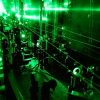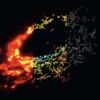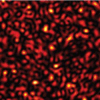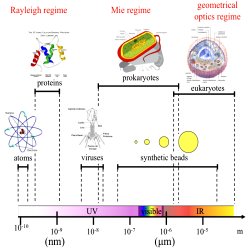-
Viewpoint on 'IONS'
Viewpoint on 'Scientific Literacy'
- Proudly sponsored by
-


-
Updating the Size of the Proton: Small Difference, Big Consequence

The proton, one of the building blocks of matter, is considerably smaller than previously measured — latest studies suggest. This result may well challenge our current understanding of nature.
-
Many Photons get More out of Diffraction

Nanoscopy has become a reality. What about the diffraction limit? Have the rules of physics been broken? What’s the trick and where’s the catch?
by Niek van Hulst -
A Rather Random Microscope

A new recipe from the microscopy world. Take a standard microscope, add a pinch of noise. Mix it all together and voilà: an image with improved resolution is served!
Light’s Pull and Push
That light can exert forces by pushing objects has been known for a while. But would you have guessed that light can also pull towards the light source, just like the optical tractor beams in Star Trek?
Optical pulling force. Solar radiation pushes comet tails away from the Sun. This is exactly the opposite of what can be seen in this artistic, and plainly unphysical, representation of a Sun exerting a pulling force on comet tails.
As a matter of fact, light can exert forces. Even though these forces are all but tiny and hardly relevant to our daily life, they have been successfully harnessed in scientific labs around the world to trap and manipulate microscopic objects, from atoms to bacteria.
In our daily life, though, it is a common experience not to feel the push of light. If you lay down in the sun on the beach, the pressure exerted on your skin by the warm solar rays is at best a million times smaller than the atmospheric pressure, and more than a billion times smaller than the pressure your body exerts on the sand. This is small, almost undetectable. Nevertheless, scientists love to try to detect improbably minute effects, and already at the beginning of the 20th century they were able to observe that light could push a little mirror. Then lasers came along and changed everything: invented in the 1960s, they permitted scientists to concentrate an unprecedented light intensity in a tiny microscopic volume and eventually to push microscopic particles. Since then, the field of optical manipulation has blossomed and grown exponentially with applications well beyond physics to medicine, biology, chemistry and soft matter.
Despite the great successes of optical manipulation, the notion that a light beam can only push a particle has not been challenged for many years. "It is indeed a commonly accepted notion that the scattering force can only push a particle," Chen, Ng, Lin and Chan explain. Of course, scientists have been able to counteract this scattering force and, for example, to trap particles in three dimensions; this has been achieved either by using several propagating laser beams whose pushes perfectly compensate each other in a point in space, or by using extreme light gradients such as those arising in a tightly focused laser beam. This latter technique is commonly known as optical tweezers and is without doubt the most successful item in the toolkit of optical manipulists.

Optical force regimes: Rayleigh regime, Mie regime and geometrical optics regime. In optical manipulation experiments, the light force is provided by a laser beam, and objects ranging from a fraction of a nanometer, such as atoms, to 10s of micrometers, such as cells, are manipulated. Considering the ratio between the characteristic dimension L of the object and the wavelength λ of the trapping light, three different trapping regimes can be defined: (1) the Rayleigh regime, when L << λ; (2) the Mie regime, when L is comparable to λ; and (3) the geometrical optics regime, when L >> λ. Optical pulling forces emerge, under the appropriate circumstances, in the Mie regime.
How does the optical pulling work? If you shine a laser beam on a microscopic particle, such as a cell or a bacterium, you will see that usually most of the light either goes through the particle unaffected or is scattered backwards — in other words reflected. This is the reason why the recoil pushes the particle. However, Jack Ng and coworkers have theoretically demonstrated that a small particle of an appropriate size and material can scatter most of the light in the forward direction under the right illumination conditions, which are achieved, for example, with a Bessel beam; in this case the recoil will pull the particle backwards. "When the forward scattering is sufficiently large," the group concludes, "we can have an optical pulling force even for simple particles such as polystyrene spheres. In principle, any object whose size is comparable with the wavelength can be pulled optically."
Speaking of possible applications for their work, Chen, Ng, Lin and Chan believe that "the optical pulling force provides an additional degree of freedom to the optical micro-manipulation." For example, it "provides an alternative method of moving biological particles" either directly or using as handles some particles optimized for the optical pulling force. "The optical pulling force can also be used in particle sorting, for only particles of the correct size will be driven backwards, while the others will be driven forwards."
The concept of an optical pulling force is a nifty, unexpected theoretical finding and it will have a significant impact both on our understanding of optical forces in general and on the various fields where optical manipulation techniques are employed. As Juan José Sáenz from the Universidad Autónoma de Madrid, Spain, pointed out [2], these results "represent a clear breakthrough in our current understanding of optical forces, and the concept of the optical pulling force will have a significant impact in the multidisciplinary field of optical manipulation."
[1] A.V. Novitsky & D.V. Novitsky, Negative propagation of vector Bessel beams, J. Opt. Soc. Am. A 24, 2844-2849 (2007).
[2] J. S. Sáenz, Laser tractor beams, Nat. Photon. 5, 514-515 (2011).
Giovanni Volpe
2011 © Optics & Photonics Focus
GV is currently working as a postdoctoral researcher in optics, statistical physics and soft matter at the Max Planck Institute in Stuttgart (Germany).

Jun Chen, Jack Ng, Zhifang Lin & C. T. Chan, Optical pulling force, Nature Photonics (2011) 5, 531-534 (link).